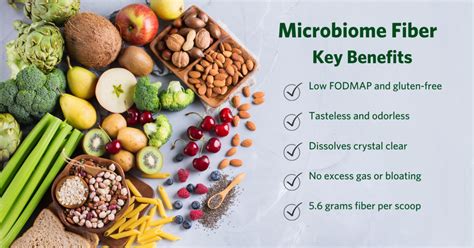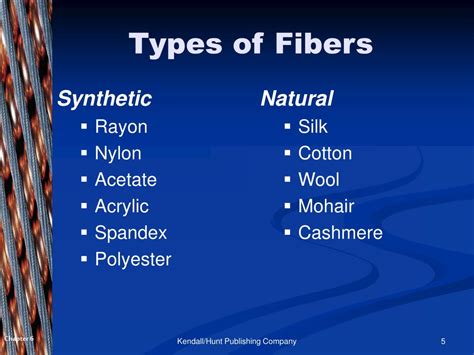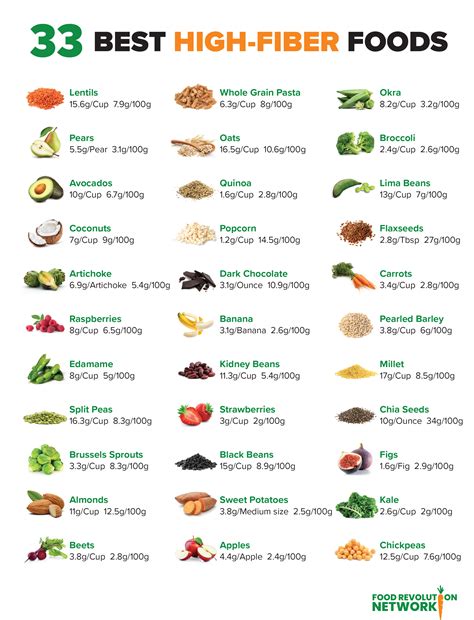Intro
Discover foods high in fiber, including fruits, vegetables, and whole grains, to boost digestive health and support healthy blood sugar levels with soluble and insoluble fiber rich foods.
The importance of maintaining a healthy diet cannot be overstated, and one crucial aspect of this is ensuring we consume enough fiber. Foods high in fiber are essential for our digestive health, satiety, and even blood sugar control. Many of us, however, fail to meet the daily recommended intake of fiber, which can lead to a range of health issues. Understanding the benefits of fiber and incorporating foods high in fiber into our diets can significantly improve our overall well-being.
A diet rich in fiber can have numerous benefits, from promoting regular bowel movements and preventing constipation to supporting healthy blood sugar levels and even aiding in weight management. Fiber also plays a critical role in maintaining healthy cholesterol levels, which can reduce the risk of heart disease. Despite these benefits, many people struggle to include enough fiber-rich foods in their meals. This can be due to a lack of awareness about which foods are high in fiber or how to incorporate them into daily meals.
The good news is that there are many delicious and versatile foods high in fiber that can easily be added to our diets. From fruits and vegetables to whole grains and legumes, there are countless options to choose from. By making a few simple adjustments to our eating habits, such as switching from refined grains to whole grains, adding beans to our meals, and snacking on fruits and vegetables, we can significantly increase our fiber intake. This article will delve into the details of foods high in fiber, their benefits, and how to incorporate them into our daily diets for a healthier lifestyle.
Benefits of High Fiber Foods

The benefits of consuming foods high in fiber are multifaceted and can have a significant impact on our health. One of the most well-known benefits is the promotion of digestive health. Fiber helps move food through the digestive system and prevents constipation by adding bulk to stool and making it easier to pass. This can reduce the risk of hemorrhoids, diverticulitis, and other digestive disorders. Additionally, a high-fiber diet can help support healthy blood sugar levels, which is particularly beneficial for individuals with diabetes. Fiber slows down the absorption of sugar into the bloodstream, preventing spikes in blood sugar levels.
Supports Healthy Gut Bacteria
Fiber also acts as a prebiotic, feeding the good bacteria in the gut and supporting a healthy gut microbiome. This can lead to a range of benefits, including enhanced immune function, improved mental health, and even weight management. A healthy gut microbiome is essential for the proper functioning of the immune system, with research suggesting that an imbalance of gut bacteria, also known as dysbiosis, can lead to various health issues, including autoimmune diseases and allergies.Types of Fiber

There are two main types of fiber: soluble and insoluble. Soluble fiber dissolves in water and forms a gel-like substance in the stomach, which can help slow down digestion and support healthy blood sugar levels. Foods high in soluble fiber include oats, barley, fruits, and vegetables. Insoluble fiber, on the other hand, does not dissolve in water and helps add bulk to stool, making it easier to pass through the digestive system. Whole grains, seeds, and nuts are good sources of insoluble fiber.
Increasing Fiber Intake
To reap the benefits of fiber, it's essential to increase our daily intake. The recommended daily intake of fiber varies by age and sex, but most adults should aim to consume at least 25-30 grams of fiber per day. However, the average fiber intake for many people falls short of this recommendation. Increasing fiber intake can be simple and delicious. Here are some tips: - Start your day with a high-fiber breakfast, such as oatmeal with fruits and nuts. - Incorporate more fruits and vegetables into your meals and snacks. - Switch from refined grains to whole grains, such as brown rice, quinoa, and whole-wheat bread. - Add beans and legumes to your meals, such as lentils, chickpeas, and black beans.Foods High in Fiber

There are many delicious foods high in fiber that can be easily incorporated into our diets. Here are some examples:
- Fruits: Avocados, bananas, apples, and berries are all high in fiber.
- Vegetables: Broccoli, carrots, Brussels sprouts, and sweet potatoes are rich in fiber.
- Legumes: Lentils, chickpeas, black beans, and kidney beans are excellent sources of fiber.
- Whole Grains: Brown rice, quinoa, whole-wheat bread, and oats are all high in fiber.
- Nuts and Seeds: Almonds, chia seeds, flaxseeds, and pumpkin seeds are good sources of fiber.
Practical Tips for Increasing Fiber
Incorporating more fiber into our diets doesn't have to be complicated. Here are some practical tips: - Keep a bowl of fruit on the counter as a reminder to snack on fruits throughout the day. - Experiment with new recipes that include high-fiber ingredients, such as lentil soups or roasted vegetables. - Add some crunch to your salads with nuts and seeds. - Try making your own granola with rolled oats, nuts, and seeds for a high-fiber snack.Challenges and Solutions

One of the challenges of increasing fiber intake is the potential for digestive discomfort, such as bloating and gas. This is often due to a sudden increase in fiber consumption, which can be overwhelming for the digestive system. To avoid this, it's recommended to gradually increase fiber intake over a period of weeks, allowing the gut microbiome to adjust. Additionally, drinking plenty of water can help prevent constipation and reduce the risk of digestive discomfort.
Addressing Common Concerns
Some individuals may have concerns about the impact of a high-fiber diet on certain health conditions. For example, those with irritable bowel syndrome (IBS) may worry that increasing fiber intake could exacerbate their symptoms. However, research suggests that a high-fiber diet can actually help manage IBS symptoms in many cases. It's essential to consult with a healthcare provider for personalized advice, especially for individuals with underlying health conditions.Conclusion and Next Steps

Incorporating foods high in fiber into our diets is a simple yet effective way to improve our health and well-being. By understanding the benefits of fiber, knowing which foods are high in fiber, and making a few simple adjustments to our eating habits, we can significantly increase our fiber intake. Whether it's starting the day with a high-fiber breakfast, snacking on fruits and vegetables, or experimenting with new recipes, there are many delicious and practical ways to make fiber a priority in our diets.
As we move forward on our journey to a healthier lifestyle, it's essential to stay informed, motivated, and supportive. Here are some next steps:
- Explore new recipes and meal ideas that incorporate high-fiber foods.
- Connect with others who share similar health goals and challenges.
- Celebrate small victories and milestones along the way.
What are the daily recommended intake levels of fiber?
+The daily recommended intake of fiber varies by age and sex, but most adults should aim to consume at least 25-30 grams of fiber per day.
How can I increase my fiber intake without experiencing digestive discomfort?
+To avoid digestive discomfort, it's recommended to gradually increase fiber intake over a period of weeks, allowing the gut microbiome to adjust. Drinking plenty of water can also help.
Are there any specific health conditions that may require special consideration when increasing fiber intake?
+Yes, individuals with certain health conditions, such as irritable bowel syndrome (IBS), should consult with a healthcare provider for personalized advice on increasing fiber intake.
We invite you to share your thoughts, experiences, and tips on incorporating more fiber into your diet. Your feedback and stories can inspire and motivate others on their journey to a healthier lifestyle. Feel free to comment below, share this article with friends and family, or reach out to us for more information on how to make fiber a priority in your diet. Together, we can support each other in achieving our health goals and living our best lives.
